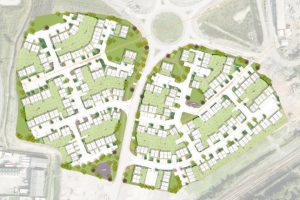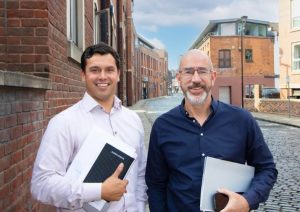Sustainability remains a key driver for the property sector in 2025

We’re a week into 2025, so we’ve sat down with leaders from across the property sector to gain an insight into what to expect this year.

Jonathan Stockton, chief executive of NG Bailey
Jonathan Stockton, chief executive of engineering and services business NG Bailey, which works across the property sector, said: “The drive to transition to a lower carbon economy is only set to intensify in 2025, so we’ll see decarbonisation, including within the built environment, renewable connections and electric vehicle charging, continue to be key trends.
“In 2025, the sector must accelerate its adoption of sustainable technologies, prioritising the integration of renewable energy systems, enhancing energy efficiency in buildings, and expanding electric vehicle charging infrastructure. We are working on all of these areas with our customers to deliver future-proofed solutions which are playing a critical role in driving the transition to decarbonisation.”
The focus on sustainability is not limited to construction, however, and is impacting the office market with employers reassessing their office requirements in the wake of hybrid working patterns and looking to persuade talent to trade their home office set ups for space in the region’s towns and cities.
Derek Devereaux, partner at Ridge and Partners in Leeds, said: “We’ve seen over the last 12 months a trend to try to attract people back into the office more regularly and expect this to continue into 2025. As a result, property owners and occupiers will be reassessing their workspace environments, likely meaning a rationalisation of floorplate sizes for some companies and a greater focus on the quality of the working environment.
“In fact, we’re now seeing the new post-Covid generation of office space come to fruition. These spaces prioritise a variety of uses from collaboration areas to solo and silent zones which support greater focus, and even other amenities such as sleep pods or event spaces.
“However, it’s not just about the fit out of buildings, we expect 2025 to see occupiers continue to look beneath the surface and appraise the operational efficiencies of offices when they’re selecting their location. As such accreditations like BREEAM in Use and Nabers will continue to gain popularity and building owners will need to be able to demonstrate and explain how their assets perform in terms of energy use and carbon outputs.”
Michael Cronin, head of portfolio at Vastint UK, the developer of Aire Park in Leeds echoed Devereaux’s comment on the changing demands of occupiers.
He said: “Occupiers in 2025 will be continuing to look for high quality office space which boasts leading sustainability, wellbeing and connectivity credentials alongside a welcoming sense of community.
“When discussing requirements with businesses, we’re seeing a greater focus on how the space will help them attract and retain talent by being a place where people want to come to spend time, work, collaborate and socialise.
“Occupiers are rightly becoming increasingly more discerning in terms of what they require from their office space. They are seeking an amenity rich and sustainable solution offering their colleagues and clients access to on-site café, retail / leisure and exercise spaces, as well as a range of efficient office options providing collaborative space, fitted options, and flexible space to allow them to adapt to changing circumstances.”

Liz Cashon, estates manager at York Biotech Campus
Liz Cashon, estates manager at York Biotech Campus, also identified the theme of sustainability. She explained that it will continue to dominate conversations in 2025, “with more organisations prioritising alignment between their ESG strategies and the buildings they occupy”.
Cashon also explained that she’s pleased that “York and North Yorkshire Combined Authority is recognising the importance of the bioeconomy in the region”, emphasising it will have a positive economic impact in 2025 particularly as Invest in York and North Yorkshire’s remains committed to attracting more business investment in agritech and industrial biotechnology, which will bolster ”the region’s growth in the sector, and we expect it’s only going to get better”.
This growth, she explained, presents an opportunity for the region’s property sector too noting that demand for lab space outside of the traditional Golden Triangle will likely lead to more retrofitting and conversion of underutilised spaces into laboratories.

Paul Pavia, head of development at MEPC
It’s not just into lab space which obsolete offices will be converted though according to Paul Pavia, head of development at MEPC, the developer and asset manager behind Wellington Place. He alluded to the fact that the drive for high quality office space will likely mean older and unused office stock is “sold at low prices and repurposed for other uses including hotel and residential”.
This repurposing he explained is causing a challenge in the region, particularly if there aren’t the new developments available to replace the older office stock which is being removed from the market.
He explained: “There is now a challenge to meet this demand as older obsolete office stock is repurposed and removed permanently from the market and constrained investment means that very little new stock will be added to the supply over the next few years.
“This is a potential concern for the growth of regional cities and the economy in general as the service sector, which is reliant on office space, is the UK’s largest industry and a key driver of economic performance. This supply demand imbalance has led to unprecedented rental growth which shows no signs of abating and rents for the best quality, best located refurbished space now exceed the rents achieved from the last phase of new build development, which is quite remarkable.”

Tarry Depledge, head of ESG at Moda Group
The drive for ESG however isn’t only impacting the office market, Tarry Depledge the head of ESG at build to rent developer Moda Group and she believes that technology is paving the way to make reporting more accurate which is crucial as it continues to grow in importance for all stakeholders, not least investors.
“The conversation around AI and ESG is going to gain a lot of traction this year. Regular advances in AI technology are paving the way for more precise and transparent ESG evaluations, which could be pivotal for businesses, investors and wider stakeholders and communities. With tightening regulations in the ESG space, AI will also play a vital role in assisting regulatory bodies with overseeing environmental and social compliance, amplifying the demand for accurate and transparent ESG reporting”, Depledge said.
But it’s not just ESG that’s key, she added: “I also think that social value reporting will increasingly play a crucial role in the evolution of ESG and in business narratives, as companies increasingly need to present a comprehensive picture of their societal impact. This openness is essential for strengthening trust and credibility among stakeholders.”
The one thing that was clear from speaking to all of these industry figures, is that sustainability and a lower carbon economy will be at the forefront of issues and opportunities for everyone in the sector.








